#the Miracleman comics are actually pretty good
Explore tagged Tumblr posts
Text
This single comic book panel, from issue 2 of the 2022 comic book "Miracleman: The Silver Age" (written by Neil Gaiman and drawn by Mark Buckingham), is pretty mindblowing and, if you'll pardon my French, a little fucked up, if you know the real-life context of it:
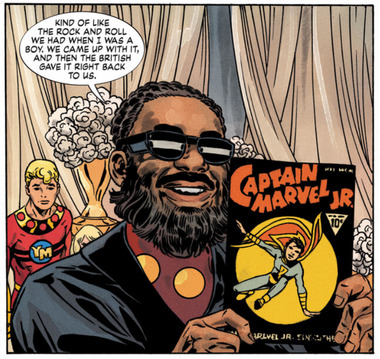
The problem is, to truly understand the context, you would have to read a long series of blog posts about the bizarre and complex history of the superhero Miracleman, AKA Marvelman. But I'll try to summarize the relevant bits: The panel is from a comic about the superhero Miracleman (and his sidekick "Young Miracleman", the guy in red in the background), which was originally created in the 1950s (originally with the name "Marvelman") by a Brittish comic book publisher (L. Miller and Son) who had previously been reprinting the American superhero Captain Marvel (and his sidekick "Captain Marvel Jr."). However, the original American publisher of Captain Marvel, Fawcett Comics, had gotten embroiled in a long legal battle with DC Comics, who claimed that Captain Marvel was a copy of Superman. Because of this, no new Captain Marvel comics were produced for a few years, and L. Miller and Son decided to create what was quite obviously a copy of Captain Marvel in the form of Marvelman. Oh, and later on Marvel Comics also had a legal spat with DC Comics (who had bought the rights to Captain Marvel from Fawcett) over the name "Captain Marvel", which lead to DC eventually changing the name of that comic to "Shazam".
Many years later, another Brittish publisher, Quality Communications, decided to make a modern, far more mature revival of Marvelman, written by Alan Moore. After a few years, Marvel Comics threatened Quality Communications with legal action because of the name "Marvelman", which pissed off Moore to the point that he has refused to write anything for Marvel ever since. Quality Communications eventually went bankrupt (though not, as is sometimes claimed, because of Marvel's threats), and just who owned the publishing rights to Marvelman after that became more and more unclear. One of the later companies who published it decided to change his name to "Miracleman" in order to avoid any future threats from Marvel.
And here's the kicker: Guess who owns Miracleman now? Marvel Comics. That's right: The panel above is from a comic published by Marvel Comics, about Miracleman/Marvelman, a character they threatened legal action against, and in that panel another character holds up a picture of Captain Marvel Jr., a character who has been involved in similar legal battles and is currently owned by Marvel's chief competitor DC Comics, though the picture is from his first appearance originally published by Fawcett Comics, a company that DC by many accounts screwed over royally. And the whole point with the panel is Neil Gaiman making a meta-commentary about the fact that Miracleman was originally a Brittish copy of the American Captain Marvel.
And just to show that all of this is just the tip of the Miracleman iceberg... Here is the same panel, with the same dialogue, drawn by the same artist, 30 years earlier:

No, I am not making that up.
#Miracleman#Marvelman#Neil Gaiman#Mark Buckingham#Alan Moore#Marvel Comics#DC Comics#Fawcett Comics#L. Miller and Son#Captain Marvel#Shazam#the Miracleman comics are actually pretty good#fair warning: they're also sometimes very gory#but they mostly tend to get talked about because of their messy legal history
8 notes
·
View notes
Text
Capsule Reviews - May 2020 - The Cape Stuff
I read a lot of comics in May. Here’s what I thought of some of the superhero and superhero-adjacent comics I read.
Arms of the Octopus
A nostalgia pick, the collection of several annual issues containing a crossover between Superior Spider-Man, The Invincible Hulk, and the All-New X-Men. It is an artifact of a very specific and bizarre time in Marvel Comics, when Doc Ock was Spider-Man, the Hulk worked for SHIELD, and the original five teen X-Men were stranded in their own future. For a pure, relatively straightforward crossover romp, it's quite enjoyable. Spider-Man is a jerk, the Hulk fights a robot, the X-Men are befuddled by the present, all of the major beats for that particular moment in the Marvel Universe are there, and it's got some really great art. Jake Wyatt, during his regrettably short-lived stint with Marvel and the great Kris Anka unfortunately overshadow the other contributors, but it's all very good, if not the most accessible comic.
Maxwell's Demons
I came to Maxwell's Demons having heard a lot of critical buzz and with my expectations set rather high. I did not care for this book at all. Ambitious is the best word for this series, and that's not a bad thing. It's got ideas, about the craft, about the genre, about philosophy in general. It never quite manages to carry things off though; it's not as smart as it wants to be, and the high-minded ideas are never incorporated in particularly elegant ways. Three of the story's five chapters are essentially extended monologues in which the main character rambles on about some glorified shower thought for 20-plus pages. The first and second chapters are the exceptions to this pattern, and are quite solid as far as pointedly derivative superhero riffs go, even if the second chapter's riff on "What if Miracleman #17 was significantly less intelligent" is more than a little shameless in its lack of originality. The fourth chapter, by contrast, is the nadir of the series, easily the most embarrassing Manic Pixie Dream Girl tripe I've seen played straight in literal years. I'm reminded a lot of Translucid, another superhero pastiche, which essentially sought to do for Batman what Maxwell's Demons seeks to do for Lex Luthor. I warmed to Translucid significantly on my second read and I wonder if the same will end up being true for Maxwell's Demons, but I find that Translucid simply did a better job of incorporating original ideas and stating its themes in ways less stupefyingly clunky than Maxwell's Demon's ever manages. I hate to call a book pretentious, especially an ambitious one, but at present that's how I feel about this book.
Twilight
Jose Luis Garcia-Lopez and Howard Chaykin's Watchmen-for-mid-century-space-heroes epic. It's good. Fabulous art, some really interesting ideas and a great premise. It's also more than a little Chaykin-y, with most of the male characters having fraught but amiable relationships with their much-too-good-for-them-and-they-both-know-it ex-wives. It has this particular brand of low grade misogyny that idealizes women but in doing so denies them interiority and, ultimately, humanity. Leaving that aside, though it is a major point to leave aside, it’s story of humanity rotting over eons of immortality, mad space gods, and humanity’s proclivity towards colonialism and genocide, it's great. It’s not an altogether pleasant book, it can be nasty and strange, in ways both intentional and unintentional, but it’s original and engaging and decidedly well made. Something of an overlooked classic of that era’s DC output.
Green Lantern: Earth One
Literally the only one of DC's Earth One graphic novels that's worth a damn. Where most of the other Earth One books choose to start things off in a world resembling our own, Green Lantern starts off in a scifi future resembling something along the lines of Ad Astra or The Expanse, with Earth controlled by an only alluded to totalitarian government, humanity colonizing and mining the solar system, and Hal Jordan as a spacefaring roughneck who dreads the prospect of returning to Earth. Earth One is the rare Green Lantern story that manages to make Earth as interesting as the rest of the universe. The bulk of the action leaves this behind to focus on unearth the lost legacy of the Green Lanterns and refits their mythology in a clean way which will be unsurprising for anyone with a passing familiarity with the original comics but is still satisfying ad fresh. Fabulous art, fun take on the mythology, I'm left both wanting more and being satisfied with what we got.
Spider-Man: Life Story
In a just world, Chip Zdarksy, one of Marvel’s best writers these days, would be writing both Spider-Man and Fantastic Four, instead of having been relegated to shortlived spinoffs. Because life just isn’t fair sometimes, instead he was given this admittedly ambitious project, his all-encompassing take on the Spider-Man story as played out in real time. In the end it’s bold and engaging, but more than a little clipped in execution. Each issue is a snippet of Peter Parker's life as we catch up to him in a new decade so readers only get a quick glimpse of the action and are left to fill in the substantial gaps by drawing on our knowledge of continuity. The obvious comparison is John Byrne's Superman/Batman: Generations, but where that story really only took the broad strokes of those characters' continuity into account in writing its decades spanning story, Spider-Man: Life Story is dedicated to the remixing of Spider-Man's publishing canon. So it can’t just take an archetypal view of Spider-Man and play that out to its logical conclusion, instead it’s stuck trying to incorporate version of prominent Spider-Man stories like Kraven's Last Hunt, Venom, and Civil War. The result means that there’s a ton of exposition in each issue, and frequent use of shorthand to gloss over things which have happened since the previous issue, and it never manages to explore the series’ original ideas in detail. Also, I'll die mad that Michel Fiffe, the genius behind COPRA and one of my favorite cartoonists, public pitched basically this exact story a year or so before this project was announced, and even if Marvel didn't actually steal the idea, I'll forever pine for Fiffe's take on this premise.
Star Wars: The Crimson Empire Saga
Long before the Disney's take on Star Wars, with their codified takes on the mythology and careful curation of the franchise, there was the old Star Wars Expanded Universe, where seemingly anyone could tell any story they wanted using the mythology of Star Wars. While it resulted in some good stuff, like Timothy Zahn's fondly remembered Thrawn books, the vast majority of it was workmanlike or even bad. Crimson Empire falls firmly into the category of bad, a dumber than dirt story about an extremely cool space guy and his code of honor. It's the kind of story where multiple characters say "He's just one man!" right before or right after seeing their legion of anonymous flunkies getting demolished by the hero. It's got an inexplicable and bad love story. In the three miniseries collected here it spends about two pages total dealing with the idea that maybe, just maybe, the fact that it's main character is dedicated to the lost honor of Emperor Palpatine, a space fascist, maybe his code of honor is completely fucked. Of those three miniseries, only the first story is anywhere near something that could be called good. I wouldn’t called Crimson Empire utterly abysmal, but it’s not unironically good. If the name Kyle Katarn means anything to you, you might get something out of this as a nostalgia trip, but otherwise it has no redeeming qualities.
Deathstroke: Legacy
The first of the New 52 Deathstroke stories, which was never well regarded until Christopher Priest took it over with Deathstroke: Rebirth, I was driven to read this by a conceptual fondness for this era's Deathstroke basically looking and acting like an action figure. Through that lens, it's quite enjoyable. It's not as obviously in on the joke in the way that the classic Taskmaster: Unthinkable is, but it's over the top, has fun designs and baddies, and Joe Bennett (years before his career best heights in Immortal Hulk) provides consistently good art. As a pure action comic, it's good.
Wolverine MAX: Permanent Rage
Here's the thing about Wolverine: There are very few good Wolverine solo stories. Wolverine is a genuinely good character, but most of his solo stories are dumb action affairs, and there's literally never been a Wolverine comic that's even halfway as good as the Logan movie. Permanent Rage, the first storyline from the Wolverine MAX series though, is actually pretty decent. It plays out a lot like you might imagine a Wolverine movie made around 2004, with no superheroes, a Japanese setting that allows for some distracting orientalism, unrelenting violence, and a noir-inspired storyline. The present day storyline is all well and good, not great, but solid and relatively low-key, but what makes the book is the presence of Sabretooth as the main villain. His relationship with Wolverine, fleshed out through flashbacks drawn by some really talented artists, is probably one of the best takes on that relationship that Marvel has ever put out. The casting of Wolverine and Sabretooth as two lonely immortals, bound together by hate and the knowledge that they are each other's only true companions, absolutely makes this book. Is it great? No, but it's got enough interesting things going on that fans of dark superheroes stories would probably find something to enjoy. Subsequent volumes of Wolverine MAX moved even further from the character’s superhero trappings and supporting characters, which is a pity, but this one remains readable and enjoyable on its own.
Marshal Law Omnibus
A collection all of the non-licensed and non-text-only Marshal Law stories. It's weird, it's punk, it's violent, it's sick of superheroes but self-aware about it own silliness in a way that Garth Ennis' work like The Boys has never been (Incidentally, the fifth story contained here, Super Babylon, is just every self-righteous complaint Ennis made about superheroes in The Boys but presented with a modicum of good humor). It's quite fun as a mean-spirited anti-superhero romp, but anyone who is particularly invested in the moral rectitude of, like, the Flash, might find it an unpleasant read so I would advise avoiding it if that's you. It's also not perfect, even for what it is: it's approach to sex work and kink is very dated, it relies on sexual violence a little too much, and by the time you get to the final story, Secret Tribunal, it's come to revel in its previously ironic fascist and misogynist imagery and characters just a little too much. The third installment, Kingdom of the Blind, is for my money, the strongest of the lot, featuring both the most straightforward premise and the most incisive satire the collection has to offer.
3 notes
·
View notes
Note
Brightburn?
youtube
So…wow. When I saw this morning that this was ‘what if Superman was a horror movie villain’ prior to watching the trailer, I assumed it would be a very general analogue standing in for the superhero genre as a whole, not a straight beat-for-beat riff on big blue with all the visual iconography in place.* And my first impression? I’m as sick as the next guy of Dark Superman - assuming the next guy is pretty fuckin’ fed up with that at this point - and I just generally don’t do horror movies period. But this looks like it could be absolutely fascinating and I’m definitely watching it.
What it comes down to is that there are three possibilities, and I’d only inherently have a negative response to one of them, and even then a largely subdued one. Firstly, there’s the chance that this isn’t a Superman commentary of substance and isn’t intending to be at all, it’s simply using the dressings of childhood comfort as a vehicle for horror, and that’s perfectly standard stuff for the genre that I don’t have a problem with in the least. The less palatable but definitely realistic possibility - especially in the current cultural climate where just fucking hating that dude is the prevailing stance - is that it is about Superman, but the sort of obvious “he’d be bad because he’s an alien/because he’d be a kid with that kind of power” deconstructive angle that doesn’t say anything but ‘if these fictional conceits of how these also fictional things work weren’t in place, it sure would turn out badly!’. And even then, that’s a shoulder shrug of disappointment and maybe some annoyance from me at most; they said their thing, they made clear they don’t like him, fine, whatever, glad you had your say, I’ll be over here with him still liking him, you be over there liking what you do like. Doesn’t directly impact Superman, so as far as I’m concerned everybody wins.

The third, riskiest but most interesting possibility (and the one I’m leaning towards given the “there is good inside you” bit from that damn pretrailer trailer that gives away the whole game)? That this does have something to say about Superman, but it’s attempting something of actual substance. Whether for or against him for that matter! I’m fine with a solid Superman deconstruction as long as it has something to say, whether trying to tear him down or illustrate his virtues by contrast. For the former, I may not think the Public Spirit of Marshal Law is much of a valid attack on Superman as a character, but that’s not the point. He’s an attack on him as an icon, and in that role he’s entirely valid as a grotesque muscled finger pointed at Superman acting as a sanitized public shorthand for America as a whole. And Irredeemable,** a comic by the guy who maybe has it out for Superman less than anyone who has ever lived, is the comic that made Superman my favorite character by interrogating the mechanics of Superman’s world and showing how they would warp and break down a lesser man. And there’s a lot of room here for that latter approach as well as the former! Perhaps this examines how the mythological touchstones for the character are mistaken for the fundamental morality he represents,*** bolstering the parental instincts of these well-meaning folks and leading them towards the mistaken but understandable belief that their boy is a good person until it’s too late? Maybe how the lessons of the character don’t necessarily translate properly into the black-and-white view of a child with the power to try and see them through, leading to catastrophic results? It could even be that it isn’t even as simple as him being an outright monster, but just a kid with problems lashing out on a monstrous scale, and the question is if the good Superman stands for that his mother still believes he has inside of him is enough to try and become a hero in spite of what he’s done. As long as it’s well done, anything in this regard would be something I’d be very much here for for the insights it could offer.
Also, since this has become a part of the narrative so quickly: aside from the sheer delightful cheek of the ‘Visionary Director’ bit (especially given it was hyping up his involvement solely as a producer in the same way as Christopher Nolan was for MOS), I don’t see this as a shot across the bow at Man of Steel (nor a ‘ripoff’ as many Snyder stans are describing it, which as a description - taken at face value given the definition and implications of the word they’re throwing around - is actually and hilariously an infinitely more devastating own on Man of Steel than anything this movie might conceivably accomplish). Of course it’s playing off those aesthetics, it was the most recent major mass-media take on the character, if Snyder had never gotten his hands on him it in all likelihood just would’ve been playing off of Donner instead. The closest I’ve seen to a solid argument suggesting it’s against that specifically is this theory that it could be a deconstruction of Ma and Pa rather than Superman, specifically in that the “you’re special and dangerous and there’s no one else like you” rhetoric could emotionally damage a child in ways that wouldn’t likely lead to Superman. And even then, minus the specific anti-helping-people deal that we can only speculate about the presence or absence of, that’s a common enough thing in Superman stories that it’d be a dig at a lot more than Snyder.
So yeah. Interested and cautiously optimistic, even if like @deathchrist2000 the logo initially made me think this was gonna be a Nameless movie and it’s a shame that’s not happening. What’s with the name though?
* Hilariously, I’ve seen Zack Snyder stans tweet that he - y’know, as opposed to Warner Brothers - should sue everyone involved with Brightburn for doing this riff on Superman that may or not be specifically riffing on his on a level beyond some visual homages. Given that crowd often goes with the “look, you fake geek plebes would have loved MOS and BVS if you read the comics” tack, I guess “the comics” didn’t include Astro City or Irredeemable or Supreme or Superior or Squadron Supreme or The Sentry or Blue Marvel or Majestic or Miracleman or Jupiter’s Legacy or Invincible or Love & Capes or that one dope arc of Hickman’s New Avengers or The Authority or Superduperman or Marshal Law.
** Speaking of which, that Irredeemable movie ever happening at this point? In the unlikely event anything’s still going on behind the scenes with it, hard to say if this paves the way or yanks the rug out from under it.
*** …okay, MAYBE then it’s kind of a dig at Man of Steel, though even then that’s a big maybe, and again would attack far more than that.
#Brightburn#Superman#David Yarovesky#Brian Gunn#Mark Gunn#James Gunn#Man of Steel#DCEU#Worlds of DC#Opinion
195 notes
·
View notes
Photo

For the week of 20 August 2018
Quick Bits:
Aphrodite V #2 is pretty damn great. Jeff Spokes’ artwork is instantly compelling, drawing in the reader with darkness and interesting angles into this increasingly enthralling story of a machine cult from the future by him and Bryan Hill.
| Published by Image / Top Cow



Avengers #6 concludes the first arc in widescreen fashion. Lots of action and big ideas from Jason Aaron with gorgeous art from Ed McGuinness, Paco Medina, Mark Morales, Juan Velasco, and David Curiel. Again I’m reminded of those early issue of JLA from Grant Morrison and Howard Porter. This has been fun so far and I’m intrigued by what else they have in store.
| Published by Marvel



Beasts of Burden: Wise Dogs & Eldritch Men #1 is a very welcome return, even without Jill Thompson for this go around. The artwork from Benjamin Dewey is beautiful as he reminds us that he’s one of the best nature artists in comics, and possible beyond. His animals are just stunning. The story from him and Evan Dorkin is also interesting, suggesting some arcane traps luring in the paranormal. Great stuff for all ages.
| Published by Dark Horse



Big Trouble in Little China: Old Man Jack #12 concludes the series with an epic battle between the forces of heaven and hell as it teaches us the true meaning of friendship. It’s funnier when you actually read it. This has been an entertaining series from John Carpenter, Anthony Burch, Jorge Corona, Gabriel Cassata, and Ed Dukeshire, with this final chapter also delivering a nice farewell to the movie as well.
| Published by BOOM! Studios



Black Hammer: Age of Doom #4 has some very interesting revelations that ultimately only lead to more questions than answers. What’s going on isn’t nearly as cut and dried as we were led to believe last issue and the mystery has just deepened. Jeff Lemire, Dean Ormston, Dave Stewart, and Todd Klein have managed to elevate this story higher again.
| Published by Dark Horse

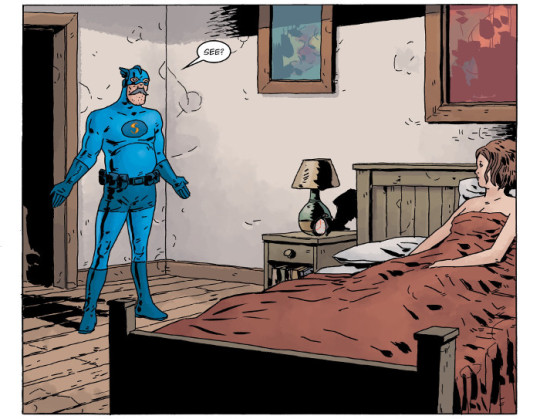

Black Panther #3 finally parcels out a tidbit of what might actually be going on with the series and the Intergalactic Empire of Wakanda, just in time for a surprise attack and more action. Thankfully, the art from Daniel Acuña is still overwhelmingly gorgeous.
| Published by Marvel



Britannia: Lost Eagles of Rome #2 is even better than the first issue. The mystery deepens as Antonius and Achillia reach Egypt and find incongruities they don’t expect within this province of the Roman Empire. The artwork from Robert Gill (with colours from José Villarrubia) is probably among the best I’ve seen from him, really bringing some very strong work here with backgrounds, vehicles, and character designs that are particularly impressive.
| Published by Valiant



Cold Spots #1 is the start to another horror series from Cullen Bunn, this time accompanied by Mark Torres with the artwork, and as per many of Bunn’s previous tales, this is a great start. There’s a genuinely creepy atmosphere from Torres’ art and the plot of a missing daughter and her child, amidst the spooky maybe-ghosts, is a good one.
| Published by Image

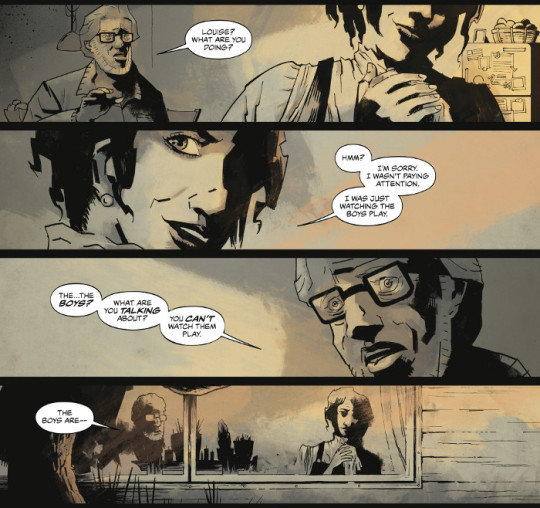

Daredevil #607 gets into how there can possibly be a Mike Murdock running around New York and it’s an interesting and possibly hazardous diversion. Gorgeous art from Phil Noto.
| Published by Marvel



Die!Die!Die! #2 is more entertaining over-the-top humorous action that feels like it’s channelling Garth Ennis. Great art from Chris Burnham and Nathan Fairbairn.
| Published by Image / Skybound



Hunt for Wolverine: Mystery in Madripoor #4 is probably the most succinct in sticking to its plot without real deviation of all of these minis. Basically sticking to the thread of these X-women tackling the Femme Fatales. It’s been a relatively decent story from Jim Zub, Thony Silas, and Felipe Sobreiro, even if the art’s been a little uneven. There’s a really nice sequence of Psylocke finding herself again in this issue, though, from Leonard Kirk and Andrew Crossley that has interesting implications going forward.
| Published by Marvel

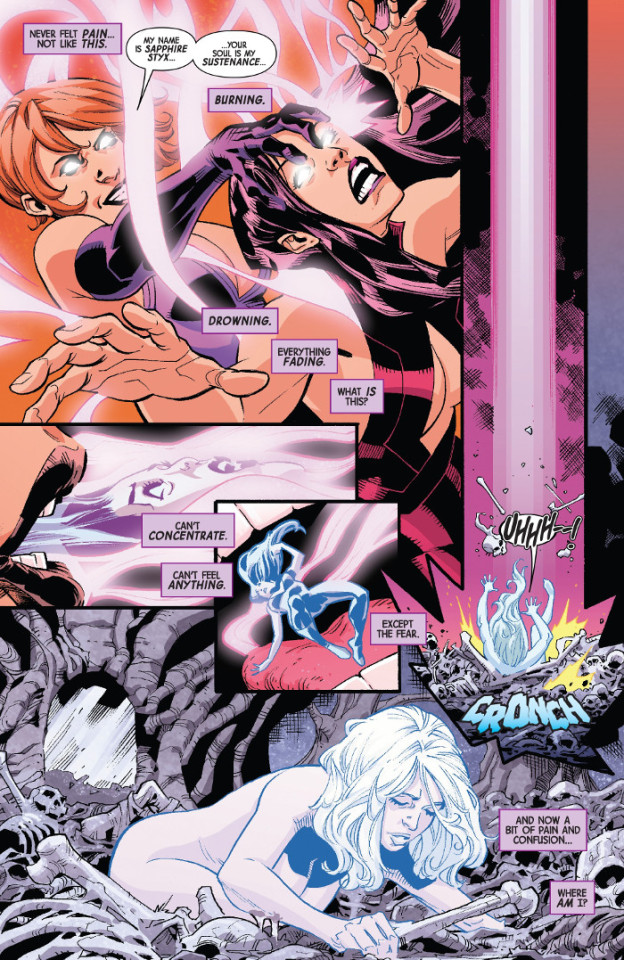

Jughead: The Hunger #8 is a great jumping-on point for new readers, offering a bit of a history lesson and summary reinterpretation of the events of the overarching plot of the series to date. Great work from Frank Tieri, Pat & Tim Kennedy, Joe Eisma, Bob Smith, Ryan Jampole, Matt Herms, Andre Szymanowicz, and Jack Morelli.
| Published by Archie Comics / Archie’s Madhouse Presents

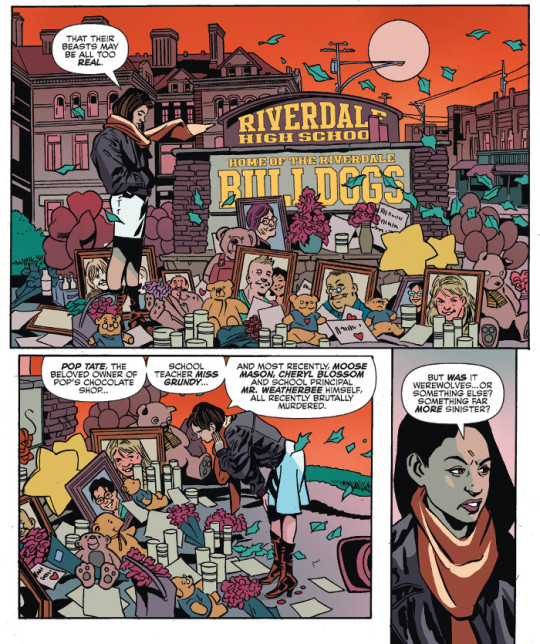

The Life of Captain Marvel #2 continues what is shaping up to be possibly one of the defining and quintessential Carol Danvers stories. I love what Margaret Stohl is doing in bringing out the backstory and interpersonal dynamics of Carol’s family. The art from Carlos Pacheco, Rafael Fonteriz, and Marcio Menyz in the present day and Marguerite Sauvage’s flashbacks is wonderful.
| Published by Marvel



Mr. & Mrs. X #2 continues this fun ride, tossing in Deadpool and more of the lesser used intergalactic X-characters. The dialogue from Kelly Thompson is hilarious and the art from Oscar Bazaldua and Frank D’Armata is great.
| Published by Marvel



Old Man Logan #46 begins another arc tying up loose ends before the endgame of Dead Man Logan kicks off. Wrapping reconnecting with Alpha Flight around a horror story evoking shades of The Thing and Slither results in a wonderful story perfectly fitting Damian Couciero’s artwork.
| Published by Marvel

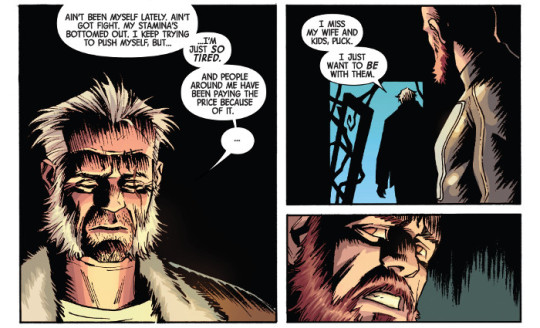

The Punisher #1 is both a continuation of Matthew Rosenberg’s stories and ideas from the last volume of the series and a kind of back-to-basics approach to Frank Castle. Basically, he’s lost the War Machine suit, but he’s still taking on the world-spanning super-villains. It’s pretty epic and this is great jumping-on point. The dark humour is perfect, reminding me of Garth Ennis’ work with Castle, and seriously this is probably the best art that Szymon Kudranski has ever done. Along with Antonio Fabela’s colours, it’s like he was born to draw The Punisher.
| Published by Marvel



Royal City #14 is an introspective end of saying farewell to the past and accepting change to move forward. This has been an interesting series from Jeff Lemire, focusing on his most often used theme of family, and it’s been a good exploration of their different dynamics.
| Published by Image



The Sentry #3 is pretty dark, telling the flipside of the first two issues from Billy Turner’s perspective as he goes about stealing Sentry’s identity. This is almost at Kid Miracleman levels of demented. Jeff Lemire is playing with some interesting ideas here, beautifully brought to life by Kim Jacinto, Joshua Cassara, and Rain Beredo.
| Published by Marvel

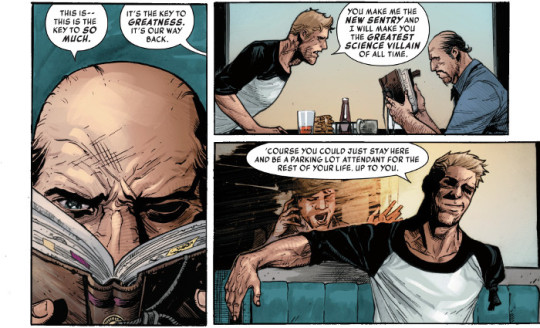

Shadowman #6 has some truly beautiful artwork from Renato Guedes, as this arc of Jack falling through time visiting the different holders of the shadow loa takes an interesting turn in ancient history.
| Published by Valiant

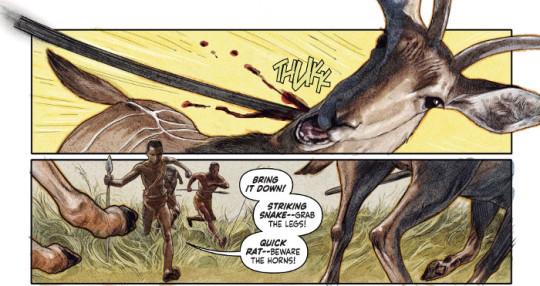

Shanghai Red #3 is probably the best issue to date, as Molly reunites with Katie, recriminations are hashed out, and we get a bit of a tour of Portland. Christopher Sebela, Joshua Hixson, and Hassan Otsmane-Elhaou have tapped into something unique here, and this tale of revenge and some of the lesser told side of American history is incredibly compelling.
| Published by Image



TMNT #85 brings Leatherhead back into the fold, with very interesting and potentially dangerous ramifications following the war between the Utroms and Triceratons. Brahm Revel’s clothes-peg take on the Turtles is an interesting visual choice.
| Published by IDW

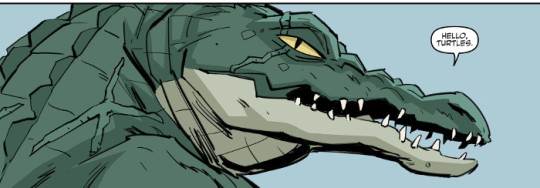

The Thrilling Adventure Hour #2 I find better than the first issue. The humour hits home a bit more for me and the leads of Sadie and Frank don’t seem nearly as insufferable as the first issue. The art, though, from MJ Erickson and Brittany Peer is just as good as the first. Entertaining stuff.
| Published by BOOM! Studios



Venom #5 is another great issue. The mythology-building in this series is just incredible, growing Venom and his world into so much more. Donny Cates, Ryan Stegman, JP Mayer, Frank Martin, and Clayton Cowles are creating magic.
| Published by Marvel



West Coast Avengers #1 is a great debut, filled with action and humour, as this highly dysfunctional team comes together. It’s nice to see Kelly Thompson doing more Hawkeye and Hawkguy, and the collection of characters coming together to make up the team are bizarre and fitting, carrying on a few of the themes and plot developments of the previous Hawkeye and America series. Though you needn’t have read any of that before you pick this up. Making it nigh unmissable is the gorgeous art from Stefano Caselli and Triona Farrell. This is fun.
| Published by Marvel



Witchblade #7 returns for its second arc, continuing the extremely high level of quality that Caitlin Kittredge, Roberta Ingranata, Bryan Valenza, and Troy Peteri set for themselves.
| Published by Image / Top Cow

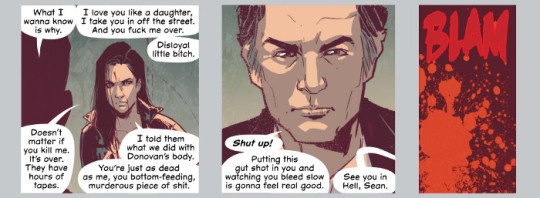

X-Men Red #7 advances us a bit further as the X-Men attempt to uncover evidence of Cassandra Nova’s influence on the world and thwart her attack on Atlantis. Tom Taylor has definitely been taking a slow approach to unfurling this story, but it has allowed for the beautiful art from originally Mahmud Asrar and now Carmen Carnero & Rain Beredo time to breathe.
| Published by Marvel



Other Highlights: Amazing Spider-Man #4, Avengers: Wakanda Forever #1, Barbarella #9, Bedtime Games #3, Betty & Veronica: Vixens #9, Curse Words Summer Swimsuit Special #1, Days of Hate #7, DuckTales #11, Gasolina #11, Hack/Slash: Resurrection #10, Hit-Girl #7, Jim Henson’s Labyrinth: Coronation #6, Lumberjanes #53, Mammon, Mickey Spillane’s Mike #3, Night’s Dominion - Season Three #2, Old Man Hawkeye #8, Quantum & Woody! #9, Red Sonja/Tarzan #4, Redneck #14, Stairway - Volume 1, Star Wars: Darth Vader #20, Star Wars: Doctor Aphra #23, Sullivan’s Sluggers, TMNT: Bebop & Rocksteady Hit the Road #4, Wasted Space #4
Recommended Collections: Avengers: Back to Basics, Bram Stoker’s Dracula, Cloak & Dagger: Predator & Pray, Deadly Class - Volume 7: Love Like Blood, Giant Days - Volume 8, Jimmy’s Bastards - Volume 2, Li’l Donnie - Volume 1: Executive Privilege, Lockjaw: Who’s a Good Boy, Postal - Volume 7, Sex Criminals - Volume 5: Five-fingered Discount

d. emerson eddy too wonders where all the cowboys have gone. Is it a nefarious plot from some shadowy organization? Or are they all just at the Calgary Stampede?
19 notes
·
View notes
Text

Back issues of Cerebus seemed to never be short of comic book satire- I say back issues as I started buying it about half way through the series, and that sort of thing seemed to become a lot less common as it moved towards its conclusion- and the aardvark’s afterlife is clearly not free of it, given that every issue’s title is some sort of play on a comic book title with appropriate pastiche cover. This feels like the most explicit parody inside the book yet- there have been various gags clearly referencing Batman, Superman and various others but these have still been with the Cerebus figure cut outs. Here those same cut outs have been given a little more decoration to make the references clearer.
I’m not sure about Alan Moore’s connection afros, but little else in this strip could be mistaken for anything but Moore jokes. From the Moore writes Superman referencing title (”Whatever Happened to the League of Yesterday?”), in a variety of fonts from Silver Ages past, to the credit stolen from recent Marvel books (”Written By The Original Writer”), to the Dr Manhattan, Tom Strong, V and Miracleman outfits given to the Cerebi, this is comic book in joke central.
“The Original Writer” is appropriately mocked: “No, Not Alan Moore. The Original Writer of this strip, obviously. We can’t get Alan Moore. Wait... We can’t, can we?” This credit is fair game, it was always a weird way of referencing Moore, regardless of his desire to not have his name printed by Marvel- it was a little too definitive and devoid of context, as though it meant the first ever writer or something. “The original writer of this strip” actually seems a little more accurate.
There’s only handful of these strips, and the mockery is less on point than Cerebus’s Roach tended to be, but they are pretty entertaining despite their brevity- V is named Dial A For Aardvark and the mask is Alexander Graham Bell, not Guy Fawkes, and no one is quite sure if another character is called Marvel Vark or Miracle Vark... It’s all a reminder of what high quality much of the parody in Cerebus was, always understanding of the medium and its history, rarely cruel even when poking fun- even knowing that Sim probably didn’t like some of the trends and characters, the mockery always seemed good natured and so well done that it would be a little churlish to take offence. It would be nice to see a bit more of this in the Cerebus In Hell? series- it’s been so long since the series ended there must be a few things that Sim missed the opportunity to share an aardvark’s eye view of.
From The League Of Extraordinary Cerebi 1, by Dave Sim, Benjamin Hobbes & Sandeep Steal (and Gustave Doré & Dante Alighieri, of course....)
1 note
·
View note
Text
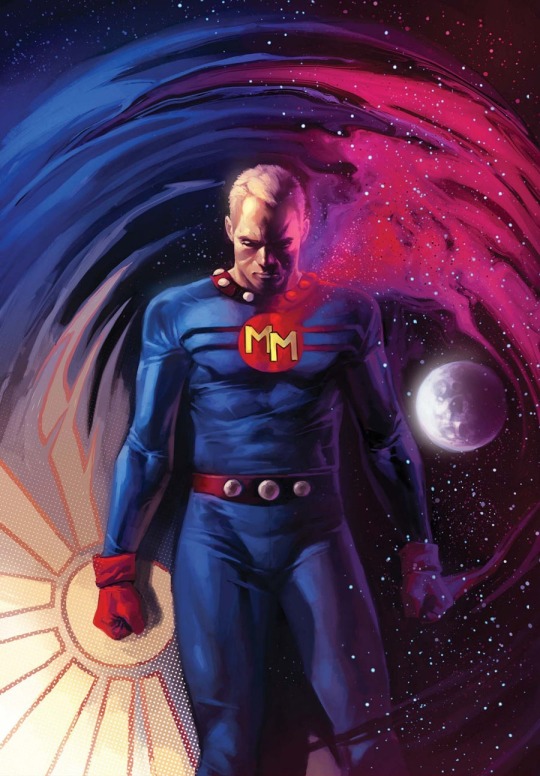
So, I just finished reading Miracleman.
What an interesting piece of work that is. I have to say, from the perspective of today, it looks kind of dated and done to death. Obviously, back then, this extreme deconstruction of a character, especially one as quintessentially kooky as Miracle/Marvel Man was obviously a massive expansion of the Mythos and ideas. I was just a bit bored of it - These days we've seen it before, power corrupts or rather it doesn't in the case of those truly heroic.
I think what's so different about the Moore run compared to the faded Gaiman run was that Gaiman had to set cast, as such and was exploring the interactions and effects of the Miracleman 'Gods' on Humanity, and how their myriad ways of fixing things benefited and destroyed humanity simultaneously, whereas Moore's run was based firmly and solidly in the conceptual realms of understanding how a superhuman would work in a world like ours. Moores was less character (dare I say it) giving us a way to examine Miracle Man without actually understanding of him. It's true third person, even if the internal narration was often from Miracle Man's perspective - we never really understood or cared for him. Or at least I didn't. Great swathes of text detailing how he felt in flowery prose as he soared through the skies was very nice to read, but I felt it didn't add much to the atmosphere or the content of the book.
The creation and relationships with the other Miracleman family characters, i.e. the Corruption of Kid Miracle Man, the death and subsequent rebirth of Young Miracleman, Miracle Woman etc. was mostly interesting, but all in all, I don't think that if this comic existed in today's market it would survive at all. Deconstructions of Golden Age characters don't tend to go over all that well these days - Project Super Powers is a good example of something which in execution I thought was pretty decent, but the characters were lacking, the plot was occasionally ponderous and it didn't really add anything new.
Miracleman did all of this at the time, in the early 80's, when it blazed a trail of the grim and gritty realisation of the times. The same way Predator and Robocop and all the other 80's films managed to balance the slightly insane elements of science fiction and make them real, and hard and gorey. Miracleman was a perfect predecessor to the modern and mature comics of today, and if you view it in the time of 20 years ago, I am sure it's probably one of the best comics around. Viewing it with a slightly jaded 15 years work of reading comics, in all forms and variations, it's actually just a bit stilited.
I'd like to have seen the continuation of Gaiman's Miracle man stories. The idea of Young Miracle man coming to terms with his sexuality and his love of Miracle Man on his resurrection would have been interesting to explore. Especially in a world which was a liberal and open as the one the Miracle Family created.
0 notes
Text
WHAT TO WATCH THIS WEEKEND May 25, 2019 - ALADDIN, BOOKSMART, BRIGHTBURN
It’s the Memorial Day weekend of one-word-titled movies, because yes, “Booksmart” and “Brightburn” are indeed single words, as much as I want to make them two words each. Sadly, I’m still running behind on stuff, and I’ve only seen a few movies, so we’ll see how I do this week. (Sadly, it’s looking more and more like this column is going to have to be put on hiatus so I can focus on paying work.)
Hey, look, it’s another Disney movie I haven’t seen yet for reasons I won’t get into. Anyway, I have a ticket to see Guy Ritchie’s ALADDIN (Walt Disney Pictures) on Friday, not because I necessarily need to see Will Smith as the Genie. In fact, I’ve never even seen the original animated movie or the musical, but I am a fan of Ritchie and his work and want to give it a look.
Fortunately, I have seen Olivia Wilde’s directorial debut, the raunchy R-rated comedy BOOKSMART, being released by U.A. Releasing moderately wide, and I have to say that it’s pretty effin’ funny with a really talented young cast, led by Beanie Feldstein (Ladybird) and Kaitlyn Dever (Detroit), who could very well be the Jonah Hill and Michael Cera for a new generation. While I hate to outright call the movie Superbad for women, it’s definitely a movie in that vein but this one from a teen girl’s point of view. It also has some amazing side characters, particularly the one played by Billie Lourde, who is quite hilarious (and isn’t even in any of the trailers!). While I saw the movie too long ago to write a full-on review, this is the movie of the weekend I recommend more than any other movie, regardless of your age and gender. Its 99% on Rotten Tomatoes is no fluke!
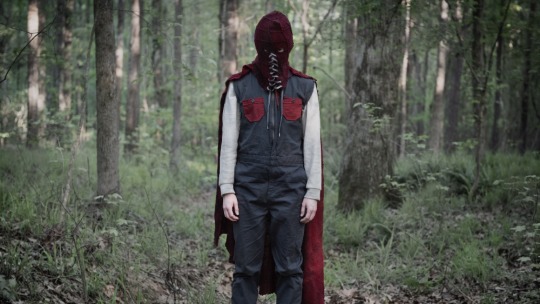
Lastly, there’s Screen Gems’ BRIGHTBURN, which is a dark take on superheroes from one of James Gunn’s brothers and one of his cousins, and of course, James Gunn produced it. It’s directed by David Yarovesky, who has done some shorts and music videos, and it stars Gunn regular Elizabeth Banks, who appeared in Slitherway back in the day, as well as David Denman, plus Jackson Dunn as Brandon Breyer, the young kid with superpowers. Since I’ve seen this one more recently, here’s my….
MINI-REVIEW: Anyone who reads a lot of comics might be aware of the concept of “Elseworlds,” essentially DC’s version of a “What If?.” If you consider yourself a connoisseur of good comics than you probably have read Alan Moore’s “Miracleman” comics. The general idea was to look at what happens when someone with superpowers allows the powers to go to their head, and they use those powers for evil purposes. It’s even more interesting when said person is still a child without the maturity needed to handle having such power.
In that sense, Brightburn isn’t a completely original idea, though it is for the world movies where there haven’t been that many alternate superhero films, let alone ones treated like horror. It takes the mythos of DC Comics’ Superman, of a baby from another alien taken in by a kindly Kansas couple, then twists it into a gory horror movie. It also deals with something I’ve always found interesting in what a kid might do if they discover they have superpowers and whether they would use them to get revenge on their oppressors, even if it’s their parents. Going by this film written by James Gunn’s brother and cousin, then the answer is “Yes.”
Brightburn begins with Elizabeth Banks and David Denman as a young couple trying to have a kid when a meteor lands nearby. We then see a montage of young Brandon Breyer growing from a baby to a pre-teen boy, and we see that he’s been having difficulty adjusting to school and life in Kansas
The results aren’t perfect and some of my issues might be due to how much is given away in the trailers, but in terms of combining things I like – superheroes and creepy kids who go on a wanton killing spree – it’s a high concept that keeps you entertained for all 90 minutes without a dull moment. That has much to do with David Yarovesky’s direction, as he has all the faculties needed to make a solid horror film, including some highly disturbing gory scenes, but also his small but capable cast.
Kind of the ultimate Richard Donner mash-up – part-Superman,part-The Omen– Brightburn isn’t perfect, but it’s a conceit that actually works to create a fun and gory time that’s more horror than superheroics.
RATING:7/10
You can read what I think of the above’s box office prospects over at The Beat.
LIMITED RELEASES
I wish I could say that I’ve seen more of this weekend’s limited release, but I’ve only watched a couple of them.

Opening at the Metrograph Friday is Gabriel Abrantes and Daniel Schmidt’s surrealist comedy DIAMANTINO (Kino Lorber), an odd Portugal-set film about a world-famous soccer superstar, Carloto Cotta, who gets caught up in a controversy over statements made about refugees. He has some evil twin sisters who like glomming onto their brother’s fame and fortune, as well as a government conspiracy. It’s a rather amusing and entertaining film for sure, which reminded me of some of the stranger films of Jean-Pierre Jeunet or Terry Gilliam, but it won’t be for everyone.
youtube
Opening on Wednesday i.e. today is Noble Jones’ THE TOMORROW MAN (Bleecker Street), starring John Lithgow as a cranky survivalist Ed Hemsler who meets Blythe Danner’s Ronnie Meisner, who he sees as a like-minded individual. This is another boring romance movie geared towards the over-50s (that me)that doesn’t really go anywhere, and I couldn’t even enjoy it for the performances by the two leads because the material just wasn’t up to snuff.
Jill Magid’s doc THE PROPOSAL (Oscilloscope) is about architect Luis Barragan, whose work was locked away in a Swiss bunker on his death in 1988, which the filmmaker has tried to bring to light as she negotiates with those keeping charge of it. Opening in L.A. at the Landmark as well as the Quad Cinemathis weekend is Frédéric Tcheng’s doc HALSTON (1091) about designer Roy Halston Frowick, who rose to fame in the ‘70s.
Next up is a trio of music docs beginning with the one I’ve seen, Barak Goodman’s Woodstock: Three Days That Defined A Generation (PBS Distribution / American Experience FIlms), which premiered at Tribeca and will get a nominal theatrical release before airing on PBS. (It will be celebrating is 50thAnniversary in August, too!) As someone who admired the more famous 1970 Woodstock concert film by Michael Wadleigh – it even won the Oscar for documentary that year! – but Goodman’s movie finds new avenues into the 1969 music and art festlval by showing its development and the lead-up to the festival as well as all the problems it faced along the way. Probably the more interesting aspect of the movie is Wavy Gravy’s contribution to the festival security with his commune of artists who actually end up saving the day more than once. (This doc will also premiere at the Quad this weekend with special guests.)
Having special shows across the country tonight and again on May 29 is Tom Jones’Asbury Park: Riot, Redemption, Rock n’ Roll (Trafalgar Releasing) about how the power of music and musicians like Steven Van Zandt, Southside Johnny Lyon, and of course, Bruce Springsteen, helped save the troubled Jersey town. You can get tickets for these special shows at the official site.
Another neighborhood music community is being honored in Andrew Slater’s Echo in the Canyon (Greenwich), which celebrates the music coming out of Laurel Canyon in the mid-60s including the Byrds, the Beach Boys, Buffalo Sprinfield and the Mamas and the Papes aka the California Sound.It opens in L.A. Friday and then in New York on May 31.
If you happened to see Paul Rudd in the film The Catcher Was a Spy last year, then you might be interested in learning more about his character Moe Berg, Aviva Kempner’s’s doc The Spy Behind Home Plate, which opens in Washington, DC this Friday and then In New York, Philly and other markets on May 31.
Gotta start wrapping up here but there’s also Rob Heydon’s thriller Isabelle (Vertical Entertainment), starring Adam Brody and Amanda Crew; as well as the Scott Adkins action-thriller Avengement (Samuel Goldwyn), directed by Jesse V. Johnson.
STREAMING AND CABLE

The movie I’m most excited about this weekend is for people to see Richard Shepard’s THE PERFECTION, streaming on Netflix Friday. It stars Allison Williams from Get Outand Logan Browning (Dear White People), and I’m not really sure what I can say about it, since I don’t want to spoil your experience. I can say that Williams plays a cello prodigy who has been off the circuit for a few years. When she returns, Browning’s character has kind of taken her place, but the two become close… and then stuff happens. Crazy stuff… stuff that you’re not going to forget anytime soon. But if you liked Get Out and Us and last year’s Hereditary, you’re probably going to like this movie that premiered at Fantastic Fest, as well. I’ve loved Shepard’s dark sense of humor from movies like The Matador and Dom Hemingway, and he has two terrific stars in this one, who seem to be up for whatever is thrown their way… and a LOT is thrown their way. I also got to interview Richard for the fourth time recently, which you can read over at The Beat.
LOCAL FESTIVALS
This year’s 26th New York African Film Festival begins on Thursday at the BAMCinematek in Brooklyn with FilmAfrica, a series of fairly recent films from a continent that just doesn’t get enough attention in the cinematic world. The opening night of the BAM leg is Jahmil X.T. Qubeka’sSew the Winter to my Sky, a Western-inspired heist film about South African bandit John Kepe. On Saturday, you can see Raoul (I Am Not Your Negro) Peck’s 2005 film Sometimes in April starring Idris Elba about the Rwandan genocide. The movie will then move next week to Film at Lincon Center, as the program continues through June 4, so I’ll write more about their offerings next week. The festival wraps up its last few days from June 5 to June 9 at the Maysles Cinema in Harlem. I honestly wish I had more time to see some of this series because it looks fantastic and many of the films may never get U.S. distribution, but I just have too much on my plate right now.
REPERTORY
METROGRAPH (NYC):
This weekend’s Late Nites at Metrograph is Katsuhiro Otomo’s Akira (1988) while the Playtime: Family Matinees is Jacques Perrin award-winning doc Winged Migration (2001) on Saturday and Sunday morning. New York Times critic Glenn Kenny is presenting Elia Kazan’s 1969 film The Arrangement, starring Kirk Douglas and Fay Dunaway, on Saturday while poet and novelist Barry Gifford is showing a double feature of Samuel Fuller’s Pickup on South Street (1953) and Jack Garfein’s The Strange One (1957) on Sunday.
THE NEW BEVERLY (L.A.):
Tarantino is in Cannes presenting his new movie (to absolute raves) but his rep theater is showing Vincente Minnelli’s 1953 film The Band Wagon starring Fred Astaire on Weds. afternoon. The week’s upcoming double features are Barbra Streisand’s Yentl (1983) and Crossing Delancey (1988) on Weds and Thurs., Sofia Coppola’s Lost in Translation (2003) and Somewhere (2010) on Friday/Saturday, and Honor Among Lovers (1931), Craig’s Wife (1936) and Sarah and Son (1930) in a Dorothy Arzner triple feature Sunday and Monday. The weekend’s KIDDEE MATINEE is the Tom Hanks-Penny Marshall movie Big (1988) and the midnight movies are the doc Full-Tilt Boogie (about the making of From Dusk til Dawn)on Friday and once again, The Love Witch, on Saturday. Next Monday’s matinee is the ensemble drama Now and Then (1995) and then Tuesday’s GRINDHOUSE double feature is Kao Pao-Shu’s Blood of the Dragon (1971) and The Master Strikes (1980).
FILM FORUM (NYC):
This weekend’s Film Forum Jr. is Penny Marshall’s A League of Their Own (1992), also starring Tom Hanks. Film Forum is also starting a new three-week 40-film (!) series called The Hour of Liberation: Decolonizing Cinema, 1966 – 1981, which includes screenings of The Battle of Algiers (1966), Ousmane Sembène’s Black Girl (1966) and other films imported from “Third World” countries with support from the Academ of Motion Picture Arts and Sciences. Concurrently, Film Forum is kicking off The Jewish Soul: Classics of Yiddish Cinema, which begins this weekend with the 1937 film The Dybbuk with a few other films running through June.
EGYPTIAN THEATRE (LA):
Cassavetes/Scorsese: Love is Strangecontinues with After Hours (1985) with Rosanna Arquette (!) and Gloria (1983) on Thursday and Raging Bull (1980) and The Killing of a Chinese Bookie (1976) on Friday. Personally, I wish I could be in L.A. Saturday for a six-film Godzilla-Thon that includes some of my favorite films from Toho including the original 1954 Gojira. Then Sunday, there’s a double feature of the Uganda-set Bad Black (2016) and Who Killed Captain Alex? (2010).
AERO (LA):
Not to be outdone by the Egyptian, the AERO presents a Memorial Day in 70mm with Hook (1991) on Thursday, a double feature of The Thing and Starmanon Friday, 2001: A Space Odyssey on Saturday and Lawrence of Arabia (1962) on Sunday. Have I mentioned how I’d love to live in L.A. this weekend?
QUAD CINEMA (NYC):
Back in New York, Fighting Mad: German Genre Films from the Marginscontinues through Thursday as well as the doc Doomed Love: A Journey Through German Genre Film.
ROXY CINEMA (NYC)
This week, the Roxy is showing Sofia Coppola’s Marie Antoinette(2006) in 35mm, as well as a screening of Joanna Hogg’s Exhibition(2013). They’re also showing Patrick Wang’s recent A Bread Factory, Part One (Friday) and Part Two (Saturday).
IFC CENTER (NYC)
Waverly Midnights: Parental Guidance screens Rosemary’s Baby and Serial Mom on Memorial Day weekend, while Weekend Classics: LoveMom and Dad shows Ozu’s Late Spring (1949) and Late Night Favorites: Spring continues withDavid Fincher’sFight Club, Tarantino’s Pulp Fiction and Pee Wee’s Big Adventure.
FILM OF LINCOLN CENTER(NYC):
This weekend, Lincoln Center begins its own Czech New Wave series with Ester Krumbachova: Unknown Master of the Czechoslovakia New Wave, running from May 24 through May 29. I still don’t know anything about the Czech New Wave then I knew a few months back, although apparently, she was a writer, director and costume designer and the series includes examples of all three.
MOMA (NYC):
It looks like Abel Ferrara: Unrated will run for the rest of the month, and this week, we get R’ Xmas (2001) on Wednesday, The Funeral (1996) on Thursday, 1989’s Cat Chaser on Friday and Saturday as well as Napoli (2009) on Saturday. Sunday sees Mary (2005) and Crime Story (1986). The Jean-Claude Carrière series continues with Luis Buñuel’s The Phantom of Liberty (1974) on Thursday, Milos Forman’s Valmont (1989) on Friday and Saturday, Cyrano de Bergerac on Friday and Sunday as well as Andrzej Wajda’s Danton (1983) plus more over the weekend. Basically, lots of interesting movie options.
MUSEUM OF THE MOVING IMAGE (NYC):
See It Big! Action is going full-throttle on Tom Cruise’s Mission: Impossible series, showing ALL SIX movies between Friday and Sunday. What a perfect Memorial Day treat! I wish I lived closer to Astoria, Queens.
LANDMARK THEATRES NUART (LA):
This Friday’s Midnight Movie is Alfred Hitchcock’s Vertigo(1958).
I also want to quickly add that the Maysles Cinema is having a Manfred Kirschheimer retrospective of sorts, in that it’s premiering his new movie Dream of a City, showing it with some of his earlier documentary works, both short and long format. Just another example of the amazing cinema that you can see in New York on any given day of the week.
0 notes
Note
Not a comics fan, but just finished Last War In Albion Volume 1 off the back of your other work and loved it. Now reading Watchmen so I can read Volume 2. Something minor that I wondered about - it's mostly chronological, but not quite. Why, for example, cover Swamp Thing before V for Vendetta?
Short answer: it seemed like the better structure.
Longer answer is that chronological is tricky with comics, because start and end dates are different things. Marvelman/Miracleman and V for Vendetta posed particular problems because they spanned from the earliest days of Moore’s career through to several years after Watchmen. And so there’s not actually a way to do a truly chronological account that’s remotely coherent as a narrative. So part of the structure of something like this is figuring out how to manage your backtracking. Indeed, a fairly clarifying way to think about the structure of a history of something like British comics (or, for that matter, cyberpunk across multiple mediums) is in terms of the backtracking. That’s the bit where you get to make decisions instead of having linear time make them for you.
So, in that regard, I had two things I wanted to have happen. First, I wanted a clear sense of rise to Moore’s career. Second, I wanted to end the book back in Britain. Part of that was that it’s dishonest to put Halo Jones anywhere but at the end - it’s not part of Moore’s rise, it’s the thing Moore did for the British market after he’d broken out in the US. Another part is that ending in the US leaves Morrison too far behind in the narrative. If I start with two Morrison chapters, I have to have him present at the end of the book as well. So I needed something to go back to the UK industry with. And I didn’t want to go straight back to Halo Jones, because that feels wrong for Halo. Her story is so focused on getting out that using it as a narrative of return feels broken.
I also didn’t really want to do V for Vendetta and Marvelman too early on, because they’d screw up the sense of rise. Their early chapters are the work of a less mature and settled writer than their later ones, and you can see that if you look, but between the presence of those later ones and the fact that the earlier ones are still the best work of his early career it’s easy to miss. Treating them as immature works is counterintuitive in the same way using Halo Jones as the return to a smaller scale and industry is. Roscoe Moscow, Doctor Who, 2000 AD, Captain Britain, Swamp Thing is a pretty orderly progression. Slot the Warrior stuff in around 2000 AD somewhere and the picture gets suddenly muddier, and for no really good reason. Especially because the same sense of talent being honed into skill appears in the 2000 AD stuff when you get to Chrono-Cops and The Reversible Man, so you don’t actually need Marvelman to get that beat. And so using the Warrior stuff for something other than “oh hey, this Alan Moore fellow is really good” makes sense, even if it was the work with which he dropped the most jaws in the UK industry.
So I opted for the optical illusion of putting V for Vendetta more or less where it appeared for American audiences, after Moore had become a superstar, and used it as my pivot back to Britain. That’s why that chapter has a totally different structure than the ones before it. Where those all meander through a bunch of influences before moving through their respective stories, V for Vendetta picks right up from the highs of Swamp Thing with a long stretch of close-reading the comic, then slowly unwinds into influences until the pace is nice and slow and we’re ready to go into the homier, quieter Bojeffries Saga, with Halo Jones accelerating back out again (but this time with Morrison one step behind him).
That sort of zig-zag structure seemed to me better for making Moore’s early career into the first act of a war. It makes Watchmen something slightly unfathomable that we bounce off of on first approach, which suits what I’m doing with it in Book Two.
Which I should get back to this summer, to head off that obvious question.
11 notes
·
View notes
Text
The Saga of the Swamp Thing and the trouble of writing comic book reviews.

So, I recently finished finished reading The Saga of the Swamp Thing (or as it’s known in more modern terms, Swamp Thing volume 2). As with every comic (and most things) I finish, I want to review it. This poses a problem, as Swamp Thing is 171 issues covered by a massive amount of different staff members with low cohesion beyond canon. Pasko’s Swamp Thing is vastly different from Moore’s from Collin’s from Millar’s and so forth. This makes it difficult to review as one piece even if I can define it with a beginning, middle, and end. I’ve reviewed comics before without problem. Even comics with multiple directions (such as Miracleman) but not on such a massive scale.
Really, the writing isn’t even the thing that makes it hard to review. I can cover disjointed writing. It’s the disjointedness of everything. In visual mediums, I like to review the visual design, and swamp thing has passed through the hands of so many artists that even recalling all of them is incredibly difficult. I can give kudos to Tatjana Wood’s coloring for by far being the most consistent thing in this comic book. So rather than formatting this like I like to on my other blog, I’m going to give this a more messy crazy whirl.
(If you’re here after Alan Moore’s Swamp Thing and just want to know if you should read the rest jump down to the very bottom (past issue 171))

To start off, let me acknowledge that this is a sequel, and should be treated as such. Since the end of the first volume, Alec Holland is Swamp Thing again (this happens in Challengers of the Unknown, but for all intents and purposes treat the last 2 issues of volume 1 as non-canon, life will be better that way.) Swamp Thing finds a peculiar situation, a man trying to kill his daughter whilst declaring her the anti-christ. Swamp Thing saves her, and thus starts on his next great arc. Unlike the individual stories of volume 1, volume 2 is more arc based. This is for better and for worse, the stories have more character, more plot, and more impact, but also this can lead to dragging and near filler. Generally I’d say it’s just alright in the first few arcs, they’re interesting but unmemorable. The story really picks up in issue 16 with a few character reintroductions, and we’re off to the races from there. Swamp Thing is a famous comic book, and for good reason. The next arcs are a work of brilliance, taking the horror hero concept through some truly interesting reconstructions with absolutely brilliant writing and amazing visual design.
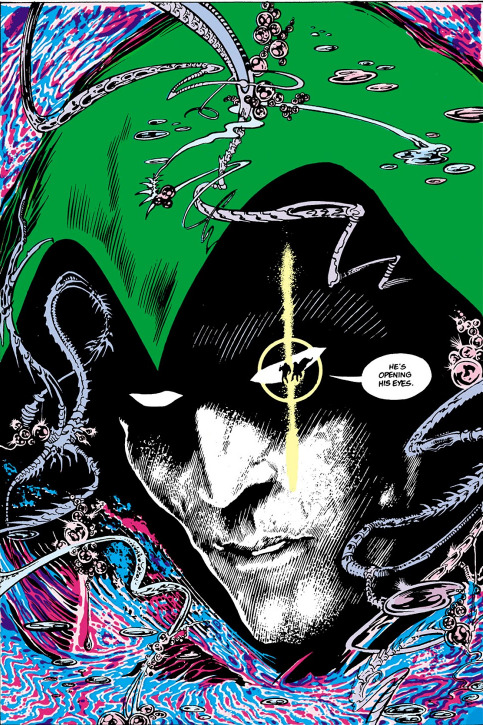
While it’s no painting, the cohesion between writing and visuals is near perfect. You can tell the team was skilled and in alignment. The Love and Death arc of this series is both an amazing story, and the arc that broke the comics code. This marked the evolution of swamp thing from the newspaper stand kids’ content to the saga of respectable storytelling we now hold comic books to be (at their best at least). But no gold rush lasts forever, and the other side of the 50 mark the series begins to cool down into an interesting but only somewhat above average niche it slides into by 100. After that, the series gets turbulent in some interesting ways, which each consecutive writer having drastically different visions and some moments that changed the story almost as much as The Anatomy Lesson did. Your mileage on the post-100 side of swamp thing will probably vary a LOT, with different tones both thematically and visually throughout the rest of the series. If you were to show me issue 166 and tell me it’s the same comic as issue 66, I would find it incredibly difficult to believe you (assuming I weren’t accustomed to these massive changes.) I can say however, that the final ending of the series is a true highlight. It pulls from the legacy of the character into quite a unique finale.
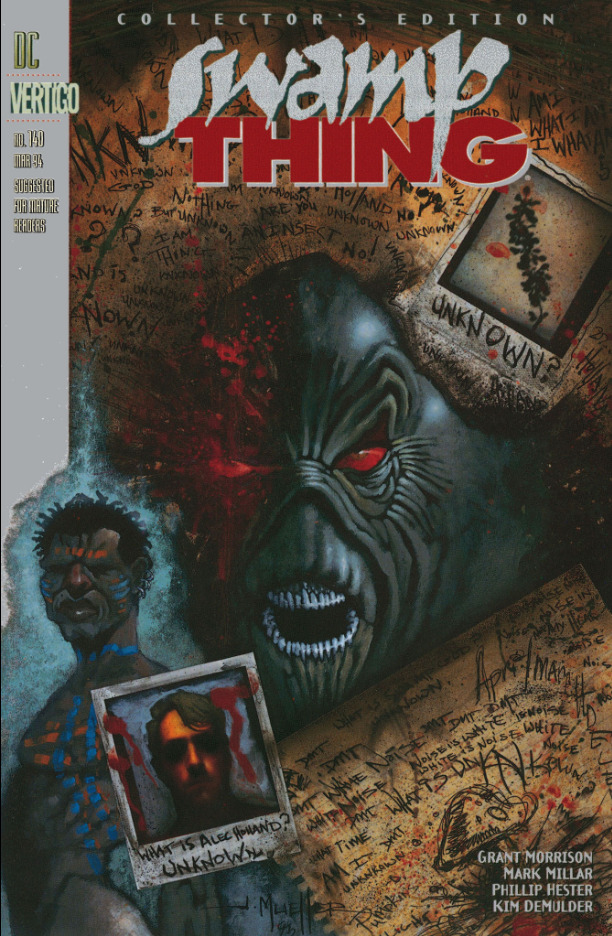
So, here’s the question. Do I recommend Swamp Thing volume 2? Short answer, yes. Long Answer, maybe? It’s status as an un-cohesive story makes it hard to recommend. Most people would recommend issues 21-64, but I’m not sure I agree. I do recommend it from the start, knowing that it will get better. Issue 64 is a great ending, and the only good drop off point until the very end. I can with little doubt recommend up to there. Beyond that is less of a solid go. I firmly believe if you carry on past that point, you will at some point grow distaste with the series. It can be all over the place, and at times I thought to myself “I’d enjoy this story if it were it’s own thing and not Swamp Thing” but I found the experience to be worth it in the end. The transition from 64 to beyond is a bit rough, as 64 feels like a good point to end end the series, but it continues on with a writer who’s clearly not as good as the writer before him. When Nancy A. Collins comes along in the early 100s, she drastically changes the tone, and with Millar starting work on the series it becomes almost unrecognizable as anything before it. I do think, despite all of this, it comes together as one good piece. I think most people will grow to dislike the series at some point, but only temporarily. So if you find yourself at issue 64 and want more, I advise you to carry on, but know it will be a crazy and imperfect experience.
Rating this series in final is difficult, at any point it was somewhere between a 6 and a 9, but usually floated around 7. Overall I think I’ll give it a 7.5, albeit a very interesting 7.5
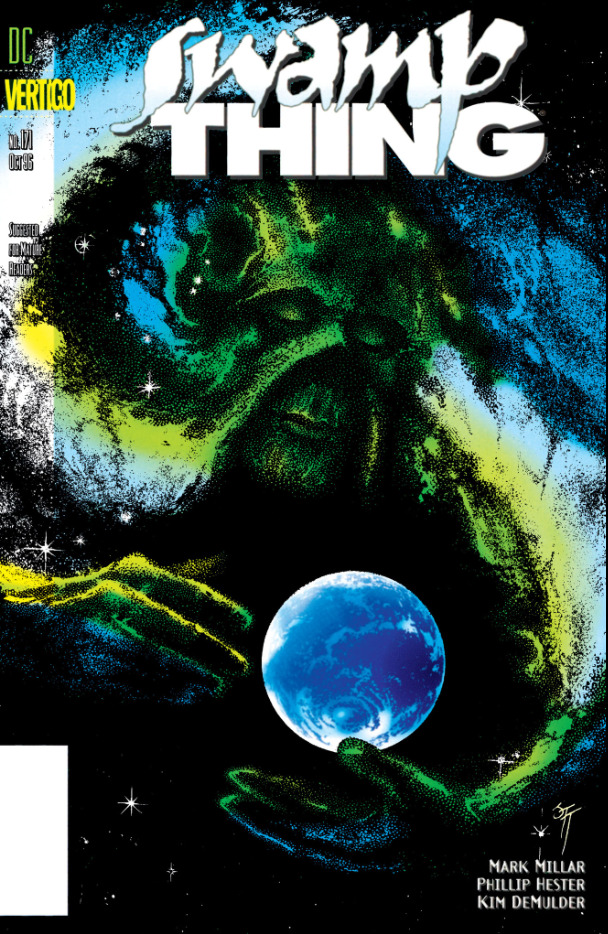
So, here’s the gloves off spoilers in section. If you’ve never read any of swamp thing volume 2, I implore you to take your leave here. This is mostly for those who have read Moore’s run. I’m going to do a run by run break down. Martin Pasko’s run (1-19) is fine. I found it enjoyable, mostly towards the very end, and it lays the groundwork for some stuff that will pay off later. Really, throw issue 20 into this as well, as it’s just an ending piece for this run. I think it’s a fine enough lead up to the Moore run, but if it existed in isolation I wouldn’t remember it one bit. I recommend it for first time readers, but if you’ve already read beyond it there’s no real point in going back to it. The Moore run (20-64) explains itself. It’s famous. It’s pretty awesome. I generally liked it, even if I didn’t love it. It’s not my favorite Moore work because I don’t think it builds on itself all that well, but the good parts are damn good and art and prose are excellent. I really feel like the space arc was definitely in the territory of “more neat than interesting” but it was a good read nonetheless. oh god my cat wants attention he’s so adorable aaaaaaaa Everytime i type he paws at me for attention ok he went to go do something else. Okay so, Rick Veitch (65-87). Veitch worked as an artist with Moore, so he and Moore are very much on the same page. Despite Moore closing the book in 64, Veitch reopens it with something that feels consistent. The nearly logical next step, the problem is Veitch is not Moore. Veitch had a shitty job, of following that up. He did it the best he could, but he just wasn’t as skilled. If you want more Swamp Thing, it will give you that, but if you want more ground-breaking comics kino, you’re out of luck. It’s a fine read, but the gap is noticeable. The other problem with Veitch is that due to the issue 88 fiasco, his plot didn’t finish by his own hands. Some people read just Veitch, but his ending isn’t an ending. He was supposed to be followed up by Gaiman (who wrote the excellent annual 5), but the issue 88 fiasco made Gaiman also back out. While this was a pretty damn respectable move on Gaiman’s part, it makes me sad wondering what that run could have been. Doug Wheeler (88-109) came in and finished up the arc and then wrote his own war epic, Quest of the Elementals. While Wheeler is a lot of the times criticized as being the bottom of the barrel for Swamp Thing, I found him to be about on par with Veitch. Interesting, but not remarkable. I do give him credit for having an actual ending to his run, which I suppose could be used as an ending point for the series but it’s clearly an arc ending and not a story ending. Then Nancy A. Collins comes in (110-138). Her Swamp Thing is tonally quite different. It’s a much slower, toned down Swamp Thing. A lot of times people describe it as being closer in tone to the pre-Moore era. I liked how it spent more time developing the supporting cast and actually giving Swamp Thing time to be at home with his family. The run was almost comfy until right after the move to Vertigo, it stopped being so. I don’t know why, but on the way out Collins decided to break the status quo, leaving a really unhappy ending. The early parts of her run were some of my favorite parts of Swamp Thing in awhile, but the ending was just upsetting. This is followed up by a one issue Black Orchid crossover, which is neat I suppose. Then we get to Millar (140-171). He starts out his run working with Grant Morrison in this 4 issue story that’s almost pure insanity. It was interesting, but really was a prologue to Millar’s greater run to come. At first I did not like Millar’s run at all. A fuckload had changed. The art was in this simplified, dynamic style that contrasted abrasively with the prior style. The story had become lonely and quite a dark downer, but it picks up. The first real arc, Parliament of Stones, is the biggest offender of being both a downer and not very good. I think from here, it really starts to improve. It still is pretty dirty and down, but it’s got a bit more humanity to it rather than just being shitty for shitty’s sake. The last stretch, Trial by Fire, was quite fantastic. It makes real good on the size of the Swamp Thing legacy, running this clearly Alan Moore like story, and just keeps pulling brilliance out until it ends on an ultimately upbeat note.I see why Millar’s run is the most recommended past Veitch, but it really is rough getting used to. Ultimately though, it justifies both itself and a lot of the weight that the series has gained.
1 note
·
View note
Text
The Best Post-Soviet Noir Superhero Comic Ever!
by Alasdair Czyrnyj
Monday, 19 April 2010
Alasdair gushes about The Winter Men.~
I don't believe in superheroes. Let's get that straight right from the start. I have no problem conceptualizing a costumed vigilante or a human with supernatural powers; such things have been a staple of popular culture for generations now, and to reject them out of hand nowadays is absurd. My problem starts once you take those characters and imagine them as figures of omnipotence, as people who are always in command, always know the score, and always win in the end, and expect your audience to take them seriously.
I suppose this problem largely stems from the fact that the first superhero comic I seriously read was
Watchmen
. Say what you will about it, but to me it remains the best example of what happens when you take pulp archetypes, characters traditionally in command of their environments, and place them in the intractable, fractal-edged mess that is the real world. Existential despair is the mildest outcome; mass murder is not outside the realm of possibility. It's the reason why the two big mainstream comic universes are these weird places that have superficial similarities to our own, but swarming with Nazi scientists, psychotic CEOs, aliens, and alternate universes. It gives the superheroes something to fight that can be defeated and doesn't leave the bad taste of moral unease afterward.
Of course, rejecting the standard interpretation of superheroes has been old hat for nigh-on two decades. Of course, stories that go against the grain have their own particular problems. Most of the time, these stories just amp up the sex and ultraviolence while leaving various core aspects of superherodom (superheroes are beholden to nothing and no one, you can solve the world with your fists) unquestioned. (Case in point:
The Boys
.) There are a few good examinations, of course; from what I've heard of it, Alan Moore's run on
Miracleman
is a pretty good depiction of the superhero as a figure of terror and of the uncomfortable compromises that would be required to "save" the world, and Kurt Busiek's
Astro City
manages to rearrange and rethink well-worn tropes to create some genuinely moving stories.
Sometimes, though, reshuffling is not enough. To truly rethink the concept of the superhero, you need to leave the American heartland of superheroes altogether and travel somewhere else. To a place which has very different ideas about power and its limits. To a place that would interpret all-powerful humans far differently than European or American society would, and would have the technology and competence to enforce its interpretations.
To travel, in other words, to Russia.
This is the premise of
The Winter Men
, the barely-released critically acclaimed Wildstorm miniseries by Brett Lewis and artist Jean Paul Leon. It had one hell of a publication history; it first appeared way back in August 2005 advertising an eight-issue run, only to finally finish on its sixth issue in February 2009. It's a damned shame that this series received such shoddy treatment from Wildstorm, especially since
The Winter Men
is one of the best superhero series out there.
The story is set in Russia in late 2001, near the end of the twilight period between the collapse of the Russian banking industry in 1998 and the emergence of Putin's "sovereign democracy." In the opening pages, we are introduced to Kris Kalenov, our guide to this world, as is roused from the snowbank where he spent sleeping off the previous night's boozy activities. A former spetznaz, now a militiaman by title and poet by aspiration, his actual day job consists of managing disputes at the behest of Moscow's mayor between the various interests (business, foreign, domestic, civil, and otherwise) that inhabit the city. An encounter with an old army buddy lands him a dead-end case about an abducted girl who had just received a liver transplant from an unknown source. In short order, hints are dropped that other factors are interested in the fate of that little girl, and her connection to the recent seismic shifts in the balance of criminal power in Moscow. Veiled references are made to something called "winter," a word Kalenov is intimately familiar with and which the CIA (ostensibly in Moscow to assist the Russian authorities with the upheavals in the underworld) is nosing around in, despite their pig-ignorance of Russia in general. At the same time, old friends of Kalenov, ex-spetznaz buddies who also have a connection with "winter," begin to reappear in Kalenov's life too fast to be chalked up to mere coincidence. While Kalenov finds the girl in first few issues, it only serves to further deepen the mystery in Moscow, as well as ask questions about what, exactly, became of the Soviet superhero program, in particular one hero known only as The Hammer of the Revolution, a Captain America-type figure that disappeared decades ago under unclear circumstances.
I won't go any farther into the plot, simply because there's a lot of it to unpack and theorize about. Instead, I will withhold most spoilers and briefly explain what makes this comic great.
First of all,
The Winter Men
may be the Russianest comic I have ever read. The care to detail is obvious even in the basic technical details. Lewis' dialogue, by some minor miracle, manages to beautifully capture the odd cadences and subtle elaboration of Russian-translated English without drifting into Boris Badenov-type kludges or, God help us, Jonathan Safran Foer-type literary schmaltz. I don't know enough to judge whether all the slang is correct or not, but it reads far better that the efforts of most writers.
Additionally, the violence in the comic has a appropriate understatement. While modern American comics love their visceral blood and mutilation,
The Winter Men
takes a more restrained approach, with the occasional high-octane gun battle counterbalanced by the dull brutishness of two drunk friends brawling, or by simply implying violence between panels. While it may seem like a dodge, it actually fits in very well with the milieu. After all, in a society like post-communist Russia, where violence is often the easiest way to do things (or, more likely, the only method anyone has any patience for), pain and death are dealt out so often that the mind (and the comic) just tunes it out and relativizes it into utilitarian indifference.
The real achievement, however, is in Lewis' depiction of Russian society. As someone who spent most of his undergraduate career plowing through 20th century Russo-Soviet history, the one thing that has grown to irritate me more than anything is the way most Westerners think Russian society works. The implicit assumption is that Russian society is a pyramid, with a tsar/gensek/president at the top, a hierarchy supporting him, all of which oppresses a servile population, with all of society neatly divided into rulers and victims. The truth, one which Lewis faithfully portrays and weaves into the greater tapestry of the series, is that Russia is a series of networks, of people organized into cabals to defend certain interests (be they organized crime, soft drink distribution, city government, or what have you), all forever fighting and securing their own power bases, forever living in fear that someone more powerful will come after them. This is nothing new, of course; you can find something similar while reading Gogol, and that model pretty much sums up the state of the Soviet Union after Stalin died. In the end, much of the series, consists of Kalenov learning to read and navigate the various circles of official and unofficial Russian power, to understand the ultimate purpose of the upheavals.
Of course, some people like some networks better than others. There is a sort of dull nostalgia running through the book for the Soviet Union, though it is more wistful than motivational. Everyone knows the USSR will never come back, but there is a sort of vague sadness among the characters for that weird socialist empire, a sense of "it was not good, but it was ours, and now it's gone." Even Kalenov himself, never a socialist, comes across as a man who, unlike his army friends, never found himself a role he could play in the Yeltsinite world to replace his previous role as a spetznaz.
This finally brings us down to the big question: what about the Soviet superheroes? What about them? The answer which slowly emerges from snatches of conversation and the occasion infodump, is the height of irony and a slap in the face to most other so-called "realistic" superhero comics. In the Soviet Union of
The Winter Men
, superheroes were
irrelevant
. The great majority of them appeared as military projects in the later stages of the Soviet Union, consisting of either men flying around in big, clunky Iron Man suits (in a neat little nod to DC comics' continuity, the suits bear a close resemblance to the Rockets Red suits that serve as fodder for the JLA to smack around) or people with genetically modified organs. While some old propaganda early in the comic shows Soviet supermen tearing their way through the American hordes, their actual purpose is to counter the super-people being developed by another faction of the Soviet military-industrial complex, while those supermen that do serve in combat tend to die ingloriously. And the end of the day, despite being the only country on the planet with superpeople, there is little difference between the fictional Russia and the real one. Even the plot of the comic only deals with the metahuman aspect fleetingly for most of its run.
I won't say much about the ending save that it will almost certainly bring back memories of
Watchmen
. However, Lewis cleverly riffs on Moore's work rather than lifting it wholesale, with the end result feeling like a bizarre version of
Watchmen
set decades after the original where everyone save one very particular character is gone, and the battle is between a meticulous autocrat that dwells in a realm of pure decision and a child of the original heroes, fighting for reasons he doesn't bother to consciously understand. At the end of the day, there's no real closure, but as Kalenov himself says, "this is a Russian story."
The Winter Men
is not a flawless diamond. The noir storytelling does tend to get a little too convoluted for its own good, with revelations losing their impact because you don't recognize a certain background character from a previous book. The publishing history really hurts the narrative, with the third and final installments clearly reading like Lewis had to cram too much in at the last minute in order to tell his story.
Still, Lewis can be forgiven his compromises. There is much to love in
The Winter Men
, from the bombastic wordplay, to the clever composition of the panels, to the characters that breathe their native land, to superheroes that are as alien to us as the East is from the West. And to one, little line, near the end of the book, whispered by one dying man to another, that may be the only fitting epitaph to the Soviet experience any writer has come up with yet.
Read it. Now.Themes:
Sci-fi / Fantasy
,
Comics
~
bookmark this with - facebook - delicious - digg - stumbleupon - reddit
~Comments (
go to latest
)
Arthur B
at 09:40 on 2010-04-19Is there a trade paperback compilation of this? I can't abide buying individual issues of comics.
permalink
-
go to top
Alasdair Czyrnyj
at 17:03 on 2010-04-19Yep, it finally came out at the beginning of this year.
Here you go.
permalink
-
go to top
Alasdair Czyrnyj
at 17:18 on 2010-04-24Oh, and fun fact: about a day after this was posted, I got an email message from Brett Lewis, the creator of
The Winter Men
asking to friend me on Facebook.
And, yes, I know that this is the year 2010, when stuff like this doesn't mean any sort of deeper connection has been made. But one the other hand...
BRETT LEWIS READ MY REVIEW! AND HE LIKED IT! AND IT'S MY BIRTHDAY! YAAAAAY!!!!!
permalink
-
go to top
http://fightsandtights.blogspot.com/
at 01:44 on 2010-04-25Great review, Alasdair, I'll definitely have to check this out. Jena Paul Leon is a big selling point for me; he did some awesome work on the Black Widow: Deadly Origin mini that was recently released by Marvel, and he really seems to portray Soviet-era Russia quite well. Certainly adding this to my wishlist...
permalink
-
go to top
Wardog
at 11:32 on 2010-04-25Belated birthday grats :) YAAAAAY!
I have to admit, when authors inadvertantly stumble across my reviews I always over-think and second guess myself into a pit of angst.
permalink
-
go to top
Alasdair Czyrnyj
at 17:10 on 2010-04-26
I have to admit, when authors inadvertantly stumble across my reviews I always over-think and second guess myself into a pit of angst.
I usually prefer to dive into that pit of angst before I start writing, when I read all the other reviews other people have written and wonder how the hell I can match the insights of all those clever and smart people whoe are better than me in every way and
isuckisuckisuck
.
Then I write the whole thing in a three-hour frenzy a week later.
0 notes
Text
A while ago, I read through the groundbreaking and highly influental British superhero comic Miracleman (a comic that is equally famous for its long history of complex and strange legal battles over copyright). This included the series "Miracleman: The Golden Age", written by Neil Gaiman, published in 1992. This comic is set in a future world ruled over by the titular superhero, Miracleman, who has managed to transform the Earth into a seeming utopia, mainly through the use of various strange and wonderful alien technologies. The first issue depicts a small group of people making a pilgrimage to Miracleman's home, in order to make wishes and requests to him. When they eventually meet Miracleman, one of the pilgrims, Gwen, make the following wish:
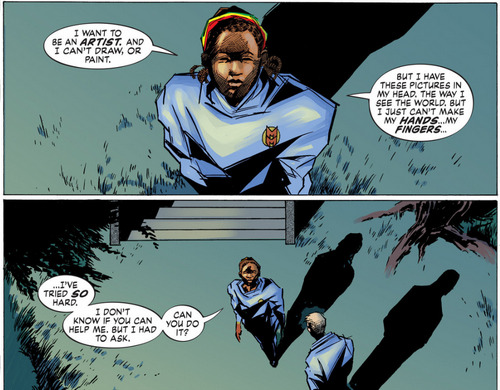
To which Miracleman replies:

Again, keep in mind that this was written in 1992. But when I've read the debate over "AI art", I often think about this part of the comic. And, interestingly enough, Gaiman seems to have done the same. In 2022 he was finally able to continue his Miracleman story with "Miracleman: The Silver Age", and it appears that he decided to show just how Miracleman had granted Gwen's wish. The new story is about his former sidekick, Young Miracleman, exploring the world and noticing signs that it might not actually be all that utopian, despite Miracleman's good intentions. This includes the following panel:

Feels to me that Gaiman makes his thoughts on the subject pretty clear there.
The thing is, when I read Gwen's original request, I could sympathize with her a lot. There have been many times when I've gotten ideas for images in my head, cool artwork that I wish I could see, that I wish I could create. But I just don't have the time and energy to sit down and learn how to draw well enough to realize these pictures. Therefore, the promises that proponents of "AI art" give are very appealing, the idea that I could just type in my idea and have the picture generated, without having to put any effort into it. Of course, I know that in reality, the result would most likely still not be very satisfactory, and would probably miss some specific details I would want. It's an impossible, wrong-headed idea that misses the point of what artistic expression is actually about, just like Miracleman seems to have missed it. But I won't deny that it's tantalizing to imagine just being able to snap my fingers and get the image in my head onto paper.
Of course, I know that the real solution is to comission one of the many wonderful artists that are out there and offering their services. Well, if you can afford it, that is. One aspect of Miracleman's utopia is that he has abolished the concept of money, and has made it so nobody needs to work just to survive. Maybe his mistake in this case was not realizing that he had already created an ideal environment for everyone to have access to art, a world where artists can take comissions from anyone, not because they have to make money to live, but purely because it's fun.
9 notes
·
View notes
Text
Another day, another SDCC news roundup/response since that’s made up the bulk of my asks.
* Not official Comic Con news, but obviously the development of the day: James Gunn has been fired from Guardians of the Galaxy Vol. 3 due to Michael Cernovich digging up rape and pedophilia jokes he had made on Twitter in 2008 and 2009 and marshaling a major backlash against him. I don’t think I’m in a place to make a call as to whether Gunn deserves it - dude absolutely had a reputation as a gross edgelord once upon a time, he seems to have cleared up his act and it was a different time in terms of what kind of shit was considered permissible to joke about, but it really was some heinous shit and there aren’t people I trust who know him claiming he’s changed since then - but the alt-right getting this kind of victory in leveraging their weight against companies, and setting this sort of precedent for the power of their voices in the process, is frightening as hell. Because make no mistake, it isn’t because Disney is appalled - they got Johnny Depp on the payroll - but because enough people made a stink, and now the worst people in the world know that’s something in their pocket that can work on a scale like this.
* Marvel Knights is returning as a line under Donny Cates’ supervision, kicking off with a 20 year anniversary oneshot by him and Mike Deodato apparently starring Daredevil, Punisher, Black Panther, and Blade. The contents of the line spinning out of it are unknown, but we know Cates will be involved along with Tini Howard, Matthew Rosenberg, and Vita Ayala. It’s an interesting prospect and I’m down for Cates, so I’m sure I’ll check out at least some of what spins out of this.
* With some unspecified legals hurdles cleared Miracleman is coming back once and for all in 2019, starting with reprinting those first two issues of The Silver Age and then finally going into Gaiman and Buckingham’s new issues wrapping up Silver Age and concluding the epic with The Dark Age. Not much to say, this is just really good news. Hopefully we get Apocrypha as well.
* Of all the rumors out in the ether, the oddest and most boring of the bunch has come true: Peter Tomasi is taking over Detective Comics with #994 in the runup to #1000 next year, with Doug Mahnke in tow. I guess we at least know James Tynion IV must have left of his own volition rather than being sidelined for a major new thing, because Tomasi ain’t that. This whole thing is just a big question mark, because...just, why? But at least it’ll look good.
* Heroes In Crisis is going to have Mitch Gerads handle a couple issues - while Clay Mann’s going to continue to do the big story, Gerads will do material focusing on individual heroes and more of the day-to-day stuff of Sanctuary as a facility. Obviously there’s only so much space for him to work with in a 7-issue mini, so very curious how much of the book will be his and how his segments will be their own thing while remaining a critical part of the whole.
* Scott Snyder talked more about Justice League, confirming what we all knew in that it’ll lead to an event comic in 2019, and revealing that Francis Manapul will be drawing the next Aquaman/Wonder Woman-centric arc (presumably Jorge Jimenez is coming back for the Superman-centric story after that, since Snyder’s already talked about his involvement in it on Twitter); he also mentioned the other Justice League-mirror Dark Knights will be returning. Perhaps most interesting though was this anecdote, picked up by Newsarama: “Snyder said Grant Morrison told him he should have Superman fly the entire multiverse to another location, 'and the best thing would be waiting there.' Snyder asked what was there, and Morrison said 'Marvel!' Morrison (perhaps jokingly?) pitched that Snyder should have Superman fly DC to the Marvel Universe.” Obviously the latter half is a goof, but sans context and being able to actually hear Snyder’s voice it’s hard to tell if this is just a hilarious story of Morrison tossing around great weird ideas, or if this is actually a legit tease for an amazing Superman moment down the line given the multiverse is at stake with the long-term plot of the book.
* Speaking of which, forgot to mention in my initial reaction to The Green Lantern yesterday - it’s also weird that Morrison’s doing something non-apocalyptic with Hal, because the IMMEDIATE assumption when Justice League #1 revealed that he had learned about the multiverse dying offscreen was that that was something Morrison was going to be dealing with in tandem with Justice League. You’d think that’d be Hal’s top priority in his own book at the moment, and given Morrison and Snyder are pretty tight at the moment, I have to imagine that’s something Morrison will acknowledge one way or another.
* Snyder will also be doing a 6-issue Batman Who Laughs miniseries with Jock spinning out of Justice League, where he goes about some mission with another Dark Multiverse Batman, one who grabbed Joe Chill’s gun in the alley and shot him, going on to basically be Bat-Punisher. If this were by anyone but Snyder it would be a hard pass with how much I hated the Batman Who Laughs oneshot, but I’m curious to see him do this bizarro take on his favorite comics mythology and maybe flesh out the concept into something as interesting as its potential. Hopefully he’ll get to show some of the interesting Dark Knights ideas he discussed having considered for Metal in interviews, such as a Batman made up of the iconography of all his villains, or a Bruce Wayne raised in Arkham Asylum when he cracked after his parents’ deaths who somehow mystically merged with it.
* Finally, we got the first trailer for Glass. I loved Unbreakable, never saw and never intend to see Split, and Shyamalan’s reputation precedes him (I’ve only seen the one film in his oevure, and while Split picked up solid reviews, that was apparently written around the same time as Unbreakable, whereas I believe this is all modern), so not sure whether I’ll be checking it out. Well, I mean, I will, but I don’t know if that’ll be opening weekend or in five years on Netflix.
#Comic Con#James Gunn#Marvel Knights#Miracleman#Heroes In Crisis#Scott Snyder#Glass#Justice League#Green Lantern#Grant Morrison#Superman#Batman#Opinion
18 notes
·
View notes